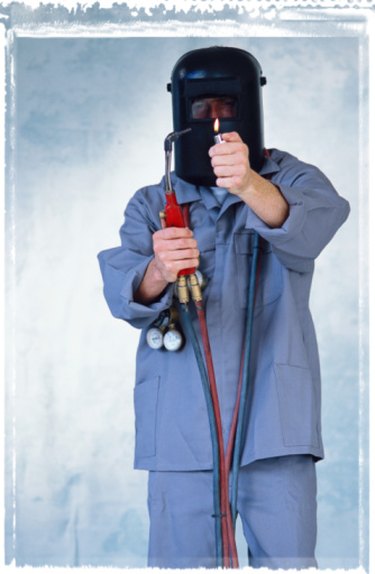
Gas welding was done with a combination of hydrogen and oxygen until the late 19th century, but the flame produced by that combination of gases was not hot enough to weld steel. In 1890 a British scientist, Edmund Davy, manufactured the first acetylene. Since it produces a much hotter flame, acetylene quickly replaced hydrogen as the gas of choice. The torch operator controls the temperature and geometry of the flame by adjusting the mixture of the two gases.
Neutral
Video of the Day

A neutral flame is one that has very nearly the same amount of both gases in the mixture. It is chemically neutral and neither oxidizes or carburizes the metal being welded. The neutral flame is characterized by a temperature around 3200 degrees Celsius (5900 Degrees F), the absence of a hissing noise, a light blue outer flame and a sharp inner white flame. You can produce a neutral flame by increasing the acetylene flow until the flame has a yellow end, then reducing it until there is a sharp, white inner cone.
Video of the Day
Carburizing
A carburizing flame is one that has more acetylene than oxygen in the mixture. The carbon in the acetylene is not completely burned, and the flame will add carbon to the metal being welded. This process is called carburizing. The carburizing flame is characterized by a temperature around 3000 degrees Celsius (5400 degrees F), a hissing noise, a ragged yellow outer envelope, a blue outer cone and a feathered white inner cone. This flame is longer than the neutral flame.
Reducing
A reducing flame is very similar to a carburizing flame but with slightly less acetylene. The flame has an acetylene feather between the inner cone and the outer envelope and is slightly hotter. It produces iron carbide when used on iron and steel making the weld brittle. You should not use a reducing flame on metals that absorb carbon.
Oxidizing

An oxidizing flame is one that has more oxygen than acetylene in the mixture. The excess oxygen can combine with many metals forming oxides. It is not useful for welding steel, but it is suitable for welding copper and zinc. Since it produces excessive slag, you seldom use it for cutting steel. The oxidizing flame is characterized by a temperature around 3500 degrees Celsius (6300 degrees F), a hissing noise, a ragged blue envelope and a sharp blue inner cone. The oxidizing flame is shorter than the neutral flame.